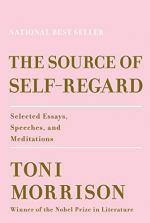
|
| Name: _________________________ | Period: ___________________ |
This test consists of 15 multiple choice questions and 5 short answer questions.
Multiple Choice Questions
1. Morrison's novel "Paradise" is set where?
(a) In an unnamed kingdom.
(b) In an all-Black town.
(c) In Jerusalem.
(d) In New York during the Jazz Age.
2. In "Gertrude Stein and the Difference She Makes," what element does Morrison say is an aspect of the European American response to chaos lacking in the indigenous response?
(a) Pragmatism.
(b) Meditation.
(c) Wonder.
(d) Disrespect.
3. In "Grendel and His Mother," Morrison notes that Beowulf is a part of Western literature's characterization of evil as what?
(a) Pervasive.
(b) A product of environment.
(c) A philosophical construct.
(d) Feminine.
4. Who was James Baldwin?
(a) A civil rights leader.
(b) A visual artist.
(c) A writer.
(d) Toni Morrison's partner.
5. In "Unspeakable Things Unspoken," Morrison introduces Rogin's commentary on Moby Dick for what purpose?
(a) As an example of how a canonical piece can be enriched by reading for the Black presence.
(b) As part of her explication of the timeline of Western literature.
(c) So that she can rebut Rogin's reading of Moby Dick.
(d) To highlight the importance of Black scholarship.
6. In "God's Language," what does Morrison say seems more true the longer she writes?
(a) The impossibility of writing.
(b) That she deserves the praise she got earlier in her career.
(c) The centrality of African American subjects.
(d) That it will be possible to merge the scientific and the artistic.
7. In "On Beloved," Morrison says that one thing that frustrates her is the absence of Black girls where?
(a) In science and mathematics.
(b) In history and literature.
(c) In elite educational institutions.
(d) In media and entertainment.
8. In "The Source of Self-Regard," what image does Morrison say she uses to convey the horrors of slavery?
(a) Shackles.
(b) A bit.
(c) Chains.
(d) A whip.
9. In "Unspeakable Things Unspoken," Morrison notes that she almost titled the essay something else--what?
(a) Canon Father.
(b) Cannon Fodder.
(c) Cannon Father.
(d) Canon Fodder.
10. In "Grendel and His Mother," what omission from Beowulf does Morrison say is significant?
(a) The impact of Grendel's actions on the Danes.
(b) The character of Grendel's father.
(c) Grendel's relationship with his mother.
(d) Grendel's motivation.
11. In "The Source of Self-Regard," Morrison recounts being asked how to teach one of her books when what was true?
(a) When there were no CliffsNotes.
(b) When the teacher is white.
(c) When students struggle to understand her language.
(d) When parents oppose the reading of her book.
12. In "God's Language," Morrison uses the word "ruminating" to describe what?
(a) Her admiration for Black women.
(b) The prayers of her childhood friend.
(c) Her contemplation of images.
(d) The kind of paradise revealed in her books.
13. In "The Trouble with Paradise," Morrison says that writers must hold "an unblinking gaze into the realm of" what?
(a) Difference.
(b) Inequality.
(c) Death.
(d) Sorrow.
14. In "The Writer Before the Page," Morrison says that she wants to do what with her writing?
(a) Tell a fictionalized account of her own life story.
(b) Question the foundations of the Western canon.
(c) Engage the reader in a participatory relationship.
(d) Challenge critics to accept a blurring between memoir and fiction.
15. In "Invisible Ink," Morrison says that she deliberately introduces ambiguity into her novels for what purpose?
(a) To make the reader participate in the construction of the novel.
(b) As a thematic reminder that the world itself is ambiguous.
(c) As an emotional challenge to the reader.
(d) To create suspense.
Short Answer Questions
1. What is one of the main subjects of Beloved?
2. In "Unspeakable Things Unspoken," Morrison brings up Bernal's two models of Greek history in order to illustrate what point?
3. What is the purpose of the Edvard Munch quote in "Memory, Creation, and Fiction"?
4. In "The Site of Memory," Morrison proposes to show how memoir is similar to and different from what?
5. In her "James Baldwin Eulogy," Morrison makes an allusion to what Biblical story?
|
This section contains 730 words (approx. 3 pages at 300 words per page) |

|




